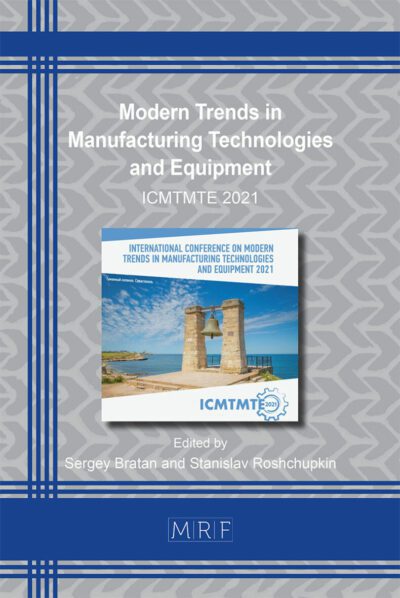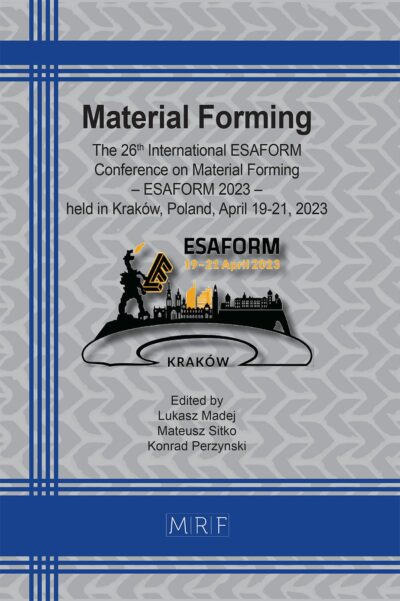Parameter settings of the PEEK and PPSU filaments production with the ceramic component
Miroslav Kohan, Samuel Lancoš, Tomáš Balint, Marek Schnitzer, Radovan Hudák, Jozef Živčák
download PDFAbstract. The aim of the work is to determine suitable settings of filament production parameters for medical applications from materials PEEK and PPSU alone, as well as with a 10wt% of the ceramic components Hydroxyapatite (HA) and Tricalcium Phosphate (TCP) admixture. Filaments were made using the Filament Maker machine (3devo, The Netherlands). The filaments were manufactured according to the requirements for usage in the FDM technology with a nominal diameter of 1.75 mm. The diameter of the filaments was measured with an optical sensor and analyzed using DevoVision software (3devo, The Netherlands). The analysis of the filament diameters was carried out using descriptive statistics in order to determine quality of the filaments. The analysis of the produced filament diameter from the materials PEEK, PEEK + HA/ TCP , PPSU and PPSU + HA/ TCP demonstrated that the measured values of the diameters of the filaments from the nominal value (1.75 mm) showed minimal deviations, as well as the fact that the limit values were not exceeded (1.85 mm; 1.65 mm) and thus it is possible to state that the manufactured filaments meet the required quality for use in FDM technology. A microscopic analysis was also carried out on the manufactured filaments in order to determine the distribution of the ceramic component in the manufactured filaments. An Olympus GX71 inverted metallographic microscope with an Olympus DP12 camera was used for the purpose of expertise. The total number of examined samples was n = 40, while 10 samples from each filament were selected from random areas. Microscopic analysis of the produced filaments showed a uniform distribution of the ceramic component in the composite filaments, which means that the manufacturing process does not affect the distribution of the ceramic component in the filament.
Keywords
Filament, Extrusion, PEEK, PPSU, Hydroxyapatite, Tricalcium Phosphate
Published online , 8 pages
Copyright © 2023 by the author(s)
Published under license by Materials Research Forum LLC., Millersville PA, USA
Citation: Miroslav Kohan, Samuel Lancoš, Tomáš Balint, Marek Schnitzer, Radovan Hudák, Jozef Živčák, Parameter settings of the PEEK and PPSU filaments production with the ceramic component, Materials Research Proceedings, Vol. 30, pp 16-23, 2023
DOI: https://doi.org/10.21741/9781644902578-3
The article was published as article 3 of the book Experimental Mechanics
![]() Content from this work may be used under the terms of the Creative Commons Attribution 3.0 license. Any further distribution of this work must maintain attribution to the author(s) and the title of the work, journal citation and DOI.
Content from this work may be used under the terms of the Creative Commons Attribution 3.0 license. Any further distribution of this work must maintain attribution to the author(s) and the title of the work, journal citation and DOI.
References
[1] SATHIES, T, Senthil P., Anoop M.S. A review on advancements in applications of fused deposition modelling process. Rapid Prototyping Journal [online]. 2020, 26(4), 669-687 [cit. 2022-11-23]. ISSN 1355-2546. https://doi.org/10.1108/RPJ-08-2018-0199
[2] SARTIPI, Farid, Kiran PALASKAR, Arman ERGIN, Uditha RAJAKARUNA. Viable construction technology for habitation on Mars: Fused Deposition Modelling. Journal of Construction Materials [online]. 2020, 1(2) [cit. 2022-11-23]. ISSN 26523752. https://doi.org/10.36756/JCM.v1.2.2
[3] DAMINABO, S.C., S. GOEL, S.A. GRAMMATIKOS, H.Y. NEZHAD, V.K. THAKUR. Fused deposition modeling-based additive manufacturing (3D printing): techniques for polymer material systems. Materials Today Chemistry [online]. 2020, 16 [cit. 2022-11-23]. ISSN 24685194. https://doi.org/10.1016/j.mtchem.2020.100248
[4] WICKRAMASINGHE, Sachini, Truong DO, Phuong TRAN. FDM-Based 3D Printing of Polymer and Associated Composite: A Review on Mechanical Properties, Defects and Treatments. Polymers [online]. 2020, 12(7) [cit. 2022-11-23]. ISSN 2073-4360. https://doi.org/10.3390/polym12071529
[5] PANAYOTOV, I. V. et al.: Polyetheretherketone (PEEK) for medical applications. In: Journal of Materials Science: Materials in Medicine. 27, 118, 2016. https://doi.org/10.1007/s10856-016-5731-4
[6] HALEEM, A. – JAVAID, M.: Polyether ether ketone (PEEK) and its 3D printed implants applications in medical field: An overview. In: Clinical Epidemiology and Global Health. 7, 4, 2019, s. 571-577. ISSN 2213-3984. https://www.sciencedirect.com /science /article/pii/S2213398418303178
[7] VICENTE BORILLE, A. – OLIVIERA GOMES, J. – LOPES, D.: Geometrical analysis and tensile behaviour of parts manufactured with flame retardant polymers by additive manufacturing. In: Rapid Prototyping Journal. 23, 1, 2017, s. 169-180. https://www.emerald.com/insight/content/doi/10.1108/RPJ-09-2015-0130/full /html
[8] SHUKLA, A. K. – ALAM, J. – ALHOSHAN, M.: Recent Advancements in Polyphenylsulfone Membrane Modification Methods for Separation Applications. In: Membranes. 12, 2, 2022, 247 s. DOI: 10.3390/membranes12020247. https://doi.org/10.3390/ membranes12 020247
[9] MA, Hongyun, Angxiu SUONAN, Jingyuan ZHOU, et al. PEEK (Polyether-ether-ketone) and its composite materials in orthopedic implantation. Arabian Journal of Chemistry [online]. 2021, 14(3) [cit. 2022-12-01]. ISSN 18785352. https://doi.org/10.1016/j.arabjc.2020.102977
[10] SENATOV, F., A. MAKSIMKIN, A. CHUBRIK, et al. Osseointegration evaluation of UHMWPE and PEEK-based scaffolds with BMP-2 using model of critical-size cranial defect in mice and push-out test. Journal of the Mechanical Behavior of Biomedical Materials [online]. 2021, 119 [cit. 2022-12-01]. ISSN 17516161. https://doi.org/10.1016/j.jmbbm.2021.104477
[11] DURHAM, John W., Sergio A. MONTELONGO, Joo L. ONG, Teja GUDA, Matthew J. ALLEN a Afsaneh RABIEI. Hydroxyapatite coating on PEEK implants: Biomechanical and histological study in a rabbit model. Materials Science and Engineering: C [online]. 2016, 68, 723-731 [cit. 2022-12-01]. ISSN 09284931. https://doi.org/10.1016/j.msec.2016.06.049













